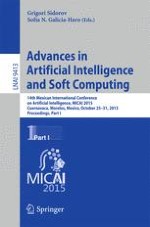The two volume set LNAI 9413 + LNAI 9414 constitutes the proceedings of the 14th Mexican International Conference on Artificial Intelligence, MICAI 2015, held in Cuernavaca, Morelos, Mexico, in October 2015.
The total of 98 papers presented in these proceedings was carefully reviewed and selected from 297 submissions. They were organized in topical sections named: natural language processing; logic and multi-agent systems; bioinspired algorithms; neural networks; evolutionary algorithms; fuzzy logic; machine learning and data mining; natural language processing applications; educational applications; biomedical applications; image processing and computer vision; search and optimization; forecasting; and intelligent applications.
